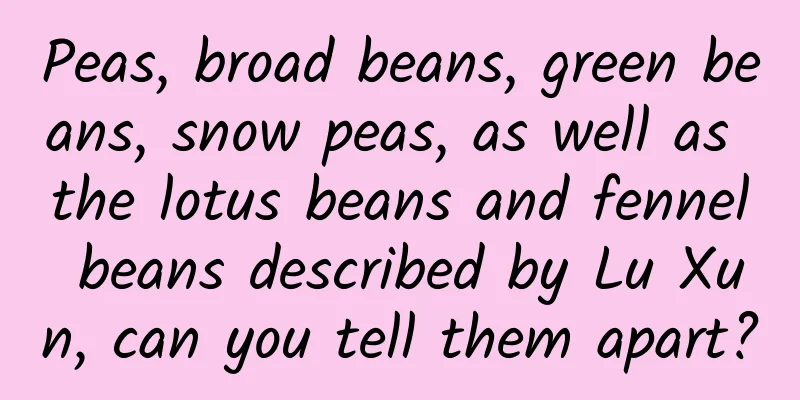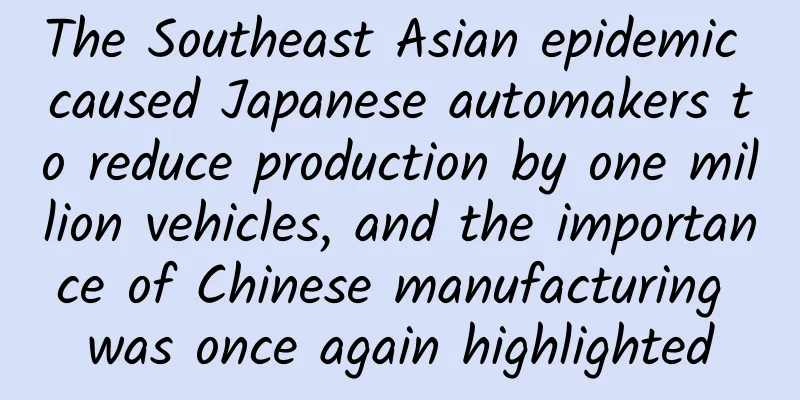Peas, broad beans, green beans, snow peas, as well as the lotus beans and fennel beans described by Lu Xun, can you tell them apart?

|
As the saying goes: Eating beans in summer is better than eating meat. The Shanghai Citizens' Life Guide WeChat account recently published a tweet that was full of mixed feelings, "To the Missed 2022 Local Broad Beans": At the turn of spring and summer, local broad beans are a seasonal delicacy that Shanghainese people cannot wait to enjoy. It has only been on the market for 7 days, 168 hours, and it is aging every minute. In order to protect its freshness, there are many "legends" about how to "serve" it. The temperature is relatively high this year, so local beans are available in late April, which is earlier than in previous years. During the long wait for the lockdown to be lifted, Shanghai residents missed out on the local delicacies they believed in so mysteriously. In this season, a dish of fresh and green beans is indispensable on the table of Hangzhou people. The only difference is the cooking method. Sometimes it is a supporting role, fried with shrimps, steamed with salted pork and glutinous rice; sometimes it is the protagonist, just cook your favorite "bean", boiled in salt water or stir-fried with oil and salt, or add some pickled mustard greens, it tastes good no matter how it is cooked. The "beans" here generally refer to two types, peas and broad beans. Hangzhou people can clearly distinguish these two kinds of beans. The small one is pea, also called cold beans; the large one is broad bean, also called soybean; the broad bean that is peeled and broken into two halves is called doubaner. However, these two seemingly ordinary beans have really confused many people because they have different names in different places. Orange user "Nanshanke" posted a message, "I remember a saying since I was a child, eat broad beans and sticky rice at the beginning of summer. In fact, the broad beans mentioned in this saying are peas, but I don't know why we call peas broad beans and broad beans Luohan beans. Is it a bit confusing?" Another person who is confused is Orange user "April". She said that every time she sees broad beans and peas, she has to go through a mental translation process to make sure she doesn't call them wrong. Otherwise, she will call broad beans peas and peas broad beans the opposite. "Because in my hometown, peas are called 'fine silkworms' or 'fine silkworms', and broad beans are called 'string beans', which sound almost the same. So after learning the characters, I naturally thought that 'fine silkworms' must be broad beans, and 'string beans' must be peas. In many places, peas are called green beans, broad beans are called Buddha beans and broad beans, and soybeans are called yellow beans. Green beans are also called edamame... Peas, who are you? We decided to study the "magical beans" carefully and let them "return to their roots". According to the main nutrients of the edible part, beans can be divided into two categories: soybeans and miscellaneous beans. In 2009, the General Administration of Quality Supervision, Inspection and Quarantine of the People's Republic of China and the Standardization Administration of China issued the "Soybean" standard, which stipulates that soybeans are divided into yellow soybeans, green soybeans, black soybeans, etc. according to the skin color. Soybeans are high in protein and fat. Yellow soybeans are yellow soybeans, which are the most consumed soybeans in our daily life. Beans have the texture that is closest to meat among plants. The clever Chinese people have made a variety of ways to eat a soybean - soy milk, tofu, tofu skin, dried tofu, fermented bean curd... The soybean can be transformed into endless possibilities. Cao Zhi wrote in his Seven-Step Poem, "Boil beans and burn bean pods", which means to boil soybeans. According to the Records of the Grand Historian, soybeans originated in China and have a history of thousands of years. Bean pods refer to bean stems. All kinds of beans except soybeans are collectively called miscellaneous beans. Miscellaneous beans are high in protein and carbohydrates, and common ones include peas, broad beans, mung beans, red beans, lentils, cowpeas, etc. In other words, peas and broad beans, which are the most popular in Hangzhou at this stage, are actually miscellaneous beans. Photo by Chengyou Lian Guoqing Because beans are so important to humans, starting from 2019, the United Nations General Assembly decided that February 10th of each year will be World Pulses Day. Humans have been eating peas for 7,000 years Peas are a common crop all over the world. It is native to western Asia and the Mediterranean coast. As early as the Stone Age around 7000 BC, humans began to pick peas for food. Around 6000 years ago, humans learned to grow peas. This crop may have spread westward from southern Europe and then gradually spread northward. It entered my country through the Silk Road around the Sui and Tang dynasties. The Guang Qun Fang Pu lists the names of peas in different dynasties, such as "Hu Dou", "Huihe Dou", "Rong Shu", "Xiao Han Dou", etc., all of which are related to the Western Regions. In Guangdong, peas are called "wheat beans" or "snow beans". In Europe before the Middle Ages, people generally ate dried pea seeds, which had to be ground into powder or cooked into porridge. How hard can dried peas be? Andersen's "The Princess and the Pea" is the best explanation. When sleeping, she had twenty mattresses and twenty beds of duck down under her, but she was still uncomfortable because of a pea on the bed. Guan Hanqing, a famous playwright of the Yuan Dynasty in my country, said that he was "a copper pea that could not be steamed, cooked, pounded, or fried, but made a clanging sound." This also explains the hardness of peas to a certain extent. Mature peas are typical beans, with high starch content and low fat content. The protein content is around 17%-25%, the fat content is basically below 1.5%, and the carbohydrate content is about twice that of soybeans, generally 60%-65%. Therefore, peas cannot be used to extract oil or make tofu, but they can be eaten as a staple food. When peas are particularly tender, they can be boiled in salt water with the pods, which is soft, glutinous and sweet. Snow peas are not Dutch beans Snow peas belong to the genus Pisum botanically, so they can be considered a type of pea. They evolved from common peas and have a flat body. There is a saying about snow peas: the Chinese call them "honey beans" and the Dutch call them "Chinese beans". Why? Snow peas are native to Asia (the Myanmar-Thailand border area south of China's southwestern border). In the 17th century, the Dutch, known as the "coachmen of the sea", discovered this bean on the Thai-Myanmar border and brought it to all parts of the world, including China. Li Ziqi, a graduate student in Chinese history at Guangzhou University, mentioned in "A Preliminary Study on the Introduction of Snow Peas into China" published in the 4th issue of "Agricultural Archaeology" in 2021 that the introduction of snow peas into China can be roughly divided into two sources. One is that during the Dutch occupation of Taiwan, China in the 17th century, they began to be planted in Taiwan and were introduced to Fujian during the Yongzheng and Qianlong periods. The second was that in the 50th or 52nd year of Qianlong's reign, Dutch merchant ships brought snow pea seeds to Guangdong for trade. They planted beans and got beans, which spread throughout Guangdong and then spread to Hainan and the areas north of Guangdong and Fujian. Sugar snap peas are a cross between peas and snow peas Sweet peas are a cross between peas and snow peas. They are tender and can be considered their "babies". The pods are plump and very similar to peas, but the beans are smaller than peas and larger than snow peas. In terms of the color of the pods, sweet peas are darker green, while peas are lighter green. But when you peel them, the opposite is true: sweet peas are lighter in color, while peas are darker in color. Why are broad beans called broad beans? This is a must-eat seasonal vegetable for Hangzhou people in late spring and early summer. There was a hot topic on Weibo, #Fava beans are like cabbage in the north in winter#. There is a saying that shelled broad beans are shaped like eyes. Eye diseases were common in ancient times. In order to eliminate eye diseases, people ate broad beans at the beginning of summer to pray for clear eyes like fresh peas and no diseases or disasters for the whole year. Like peas, broad beans are not native to China. They are native to the Mediterranean coast and have been grown and eaten by humans for a very long time. People have been growing broad beans since the Neolithic Age, and they have even been found in ancient Egyptian tombs. Broad beans grow very fast and have a relatively balanced nutrition. They are widely planted in many countries. Duan Jiezhu, director of the Yunnan Dali Academy of Agricultural Sciences, has done research and found that broad beans are one of the world's major legume crops, with more than 70 countries cultivating them on an area of more than 4 million hectares. China is one of the countries with the largest area of broad bean cultivation, with an area of more than 1.4 million hectares. Chinese people love to eat broad beans, but they are mainly concentrated in the Jiangnan area. Wang Zengqi said in "Broad Beans" in "Eating Beans and Drinking Water Studio": "Beijingers don't know how to eat fresh broad beans. Beijingers love to eat lentils and cowpeas, but don't appreciate broad beans." But people in the Jiangnan area regard fresh broad beans as a godsend delicacy. Spring without broad beans has no soul. Wang Shishen, a Qing Dynasty painter and one of the Eight Eccentrics of Yangzhou, once described it in his "A Scroll with the Fragrance of Broad Bean Flowers": "Broad bean flowers bloom against the backdrop of mulberry trees, their fragrant stems and green leaves exude fragrance. No one loves the wild bean in the fields, it does not follow the east wind and mixes with the fragrance." As for the origin of the name of broad beans, Wang Zhen of the Yuan Dynasty mentioned in the "Book of Agriculture" that "the beans are ripe when silkworms are born, hence the name". He believed that broad beans were picked when mulberry trees were being picked and silkworms were being raised, hence the name. Li Shizhen of the Ming Dynasty said in "Compendium of Materia Medica, Grain Section, Volume 24, Broad Beans" that "the bean pods are shaped like old silkworms, hence the name". This is named after the shape. The third month of the lunar calendar was called the Silkworm Month in ancient times, which is the end of spring. Photo by Orange friend Small Wei Orange Friends march forward bravely 1 Broad beans grow in a very wild way, desperately upwards, without much fertilizer or watering, they grow up and mature on their own. In the past two days, when you go to the market, you can easily find large bags of broad beans filled with plastic bags, piled together, 10 yuan for 5 kilograms. The quick-handed "Ma Dasao" will shell the beans directly on the roadside after buying them. Luohan beans and fennel beans are both broad beans Broad beans have different ways of being eaten, from tender to old. The most classic pairing is stir-fried with mustard greens. Yuan Mei included a description of how to cook broad beans in his Suiyuan Food List: "The tender new broad beans are stir-fried with pickled mustard greens, which is very delicious. They are best eaten as soon as they are picked." Another way to eat it is to boil it in water. Lu Xun said in "Call to Arms: The Village Opera": "Lohan beans are in full bloom, and firewood is readily available. We can steal some to cook." Usually when we roast them, we have to cut a hole at the bean mouth to make it easier to spit out the shells when eating. As the temperature gradually rises, tender broad beans slowly turn into old broad beans and are no longer suitable for stir-frying. Their best destination is to be made into fried broad beans or "fennel beans". Fried bean paste orange friend Ning Jing photo Most people know fennel beans from Lu Xun's "Kong Yiji". This snack from Shaoxing, Jiangnan, is salty, fresh and mellow, with a long aftertaste. Broad beans may be loved by those who love them and they will never get tired of eating them every day, but some people do not like them at all. They always feel that they have a strange smell, which is very similar to "foot odor". Of course, there are some people who are born unable to eat broad beans. This is a disease called favism. Favism, the full name of which is glucose-6-phosphate dehydrogenase deficiency, is a common congenital genetic disease. As the relevant gene is located on chromosome X, people with favism are mainly males, and the incidence rate among Chinese males is approximately between 2% and 5%. If you don't have favism, you can eat broad beans with confidence. The only thing you need to pay attention to is that eating too many beans can easily produce gas in the stomach and intestines, which is not very friendly from a social point of view. Edamame is unripe soybeans Some people may ask, why didn’t we mention edamame, which occupies an absolutely important position in the hearts of Hangzhou people? Edamame is called edamame because of its many fine hairs on the outer skin. Edamame is not a mixed bean, but soybean, which is a kind of immature soybean, also called vegetable soybean. When edamame matures, it becomes dehydrated, smaller, and harder and becomes soybeans. The protein and calcium content of edamame is among the highest in the vegetable world. Every 100 grams of edamame contains about 13 grams of protein, which is comparable to eggs, and every 100 grams contains 135 milligrams of calcium, which is higher than milk. In the summer, Hangzhou people can't do without edamame. But now is not its main season. You have to wait until the weather is hot and humid, open a bottle of ice beer, and pair it with boiled edamame in salt water, fried edamame with dried fish, or stir-fried edamame with pickled cucumbers. It can be called the "three treasures of appetizers". Green beans and peas are not the same thing Green beans and peas, although they are both green in color, are completely different. Real green beans should be called "green soybeans", which, like soybeans and black beans, belong to the soybean family. How can you join the soybean family? The main thing is to look at protein and fat, both high. Green beans meet this condition, while peas have less fat. Although green beans can also be used to make soy products or extract oil, the most common way to eat them is as a snack, such as stir-frying green beans. How to distinguish between Pea and Bean? Different beans have different names abroad. Because beans are so important to humans, starting from 2019, the United Nations General Assembly decided that February 10th of each year will be World Pulses Day. In foreign countries, people often cook various types of beans, and also mix the tender beans directly with olive oil to make cold salads. In English breakfast, the indispensable baked beans are usually made of white beans (Haricot beans); Italians eat beans with sausage; the traditional German combination is sauerkraut and pork, plus a bowl of lentil soup (Lentils Soup); in many southern states of the United States, people will eat coin-shaped beans, such as black beans, on New Year's Day to pray for prosperity and good luck. Although both Pea and Bean mean beans in Chinese, they are not the same climbing plant. Pea plants are hollow and their fruits are whole, while Bean plants are solid and their fruits can be broken into two halves. Mung Bean Soybean Red Bean Broad Bean String Bean Pea Cowpea Chickpea Snow Pea Pea comes from Middle English Pease, which was originally derived from Old English Pise. Later, people mistakenly thought it was a plural form and it was directly shortened to Pea. Old English Bean comes from Proto-Germanic Bauno, and there are many cognates: Old Norse Baun, Middle Dutch Bone, Dutch Boon, Old High German Bona, German Bohne. Beans as a metaphor for "something of little value" is attested to have been used as early as 1300, and "not worth a hill of beans" can still be used to express that something is worthless. In British folklore, the concept of lucky beans or magic beans comes from the exotic beans or large seeds that occasionally washed up in Cornwall and western Scotland, brought by the Gulf Stream from the Caribbean or South America. These beans were particularly prized and believed to ward off the evil eye and aid childbirth, and today "full of beans" is used to describe people with high energy. What do you call "peas" and "broad beans" in your hometown? What kind of beans do you like best? Chengshi Interactive·Metropolitan Express reporter Yu Xiwen Zhu Jingning Photo by Chen Zhongqiu |
Recommend
How to build and set up a Baidu search promotion account? How to build an account for Baidu promotion?
Beijing Wei Zhimeng Flower Shop is a newly opened...
“After eating one mouthful, your neck stretches out two miles.” What exactly is dry choking yogurt?
Recently, a kind of "dry choking yogurt"...
What does it mean for smart home hardware manufacturers to connect with Tencent?
On October 30, 2014, Tencent Global Partner Confe...
Good news for designers: Apple releases Figma design kit, covering all resources for iOS 17 and iPadOS 17
On June 8, Apple brought a surprise to designers ...
A small project that can earn you hundreds of dollars in 2 hours a day. It is easy to understand.
A small project that can earn you hundreds of dol...
Does heading the ball in football really affect the brain?
Compiled by: Gong Zixin At a football game Pass, ...
Help! How can the virus he draws be so beautiful!!!
On Earth, the interconnected roads, the densely p...
This may be the smallest cat in history, living in Anhui | Natural Trumpet
Welcome to the 74th issue of the Nature Trumpet c...
How to write product titles for Kuaishou stores? What are the things to pay attention to?
This article mainly introduces how to write produ...
The proportion of the five-tier color TV market has increased, and independent channels have become the dominant
After more than five years of large-scale stimulu...
Alibaba and SAIC: What handshake? What peace?
The recent conflict between Alibaba and the State...
Foreign online earning projects: once and for all, earn over 100 US dollars a day through pipeline income
Today I will share a foreign online earning proje...
How to safely call JS and Java in WebView
[[120265]] In the current Android native applicat...
Changsha Yuelu District tea drinking tea high-quality girls live audition to share with you reliable resources
High-quality girls who enjoy drinking tea in Yuel...
The blue sky and white clouds were all gone. It’s not our fault. It’s because the camera is not powerful enough.丨World Photography Day
Produced by: Science Popularization China Author:...









